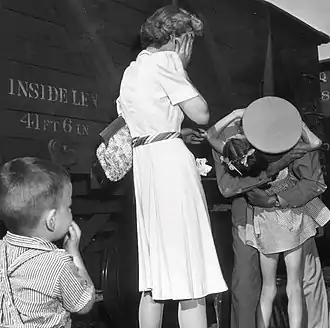
Homecoming is the 1944 photograph of a soldier returning from war. The image was captured by Earle Bunker and it won the 1944 Pulitzer Prize for Photography. The image also won a national Associated Press news photo contest and it was featured in Life, Time and Newsweek.
History
On July 15, 1943, photographer Earle Bunker waited at the train depot in Villisca, Iowa.[1] The town of Villisca, Iowa had a population of 1,100 and many came to the train station to welcome Lieutenant colonel Robert Moore home from war. Omaha World-Herald photographer Earle Bunker was also at the station waiting to capture the homecoming. Earle Bunker has said that he waited 24 hours to take the picture.[2]
On February 17, 1943, Moore led a battalion of Iowa natives at Faid Pass battle. In December 1942, Lt. Col. Robert Moore had received the Silver Star for gallantry in action for his action in Algeria. On July 10, 1943, Mrs. Moore received the News that her husband would be returning home.[3]
Pulitzer Prize
The image was selected along with another image to share the 1944 Pulitzer Prize for Photography. Many of the images which were submitted that year had a World War II theme. The Pulitzer Prize jurists were Robert E. McAlarney and Fred J. Pannwitt and they selected two war related photographs to win the 1944 Pulitzer Prize for Photography. Frank Filan's image entitled "Tarawa Island" and Bunker's "Homecoming were very different images but they shared the 1944 prize.[4]
Description
Lt. Col. Robert Moore was returning from North Africa and he was met by his wife, Dorothy Dee (née) Moore, his 6-year-old daughter, Nancy; and his 2-year-old nephew named Michael Croxdale. None of the faces of the subjects are visible in the image.[1] Bunker has said the flash bulb on his camera had failed on his first attempt to take the photo. He tossed the bulb under the train and he had to reset his camera, which was a 9-pound Speed Graphic camera. He then had to rush the next shot and hope that the timing was right. He spun around and pressed the button just in time to capture the scene and his flash worked.[1][5] The image was described as a father returning from a 16 month deployment as his young daughter falls into his arms.[4] James Collings described the scene as "a scene of a soldier crushing his daughter in his arms at a railroad station".[6]
Reception
New York Daily News columnist Ed Sullivan, said, "It is one of the all-time top pictures of the war."[1] It won a national Associated Press news photo contest and was used on literature distributed by the American Red Cross.[7] The image was featured in Life, Newsweek and Time. Newsweek said, "a picture that ranks with the war classics."[1] The image was entered in an Encyclopædia Britannica image contest and on On May 1, 1944 it placed third.[8]
References
- 1 2 3 4 5 Jones, Sheritha (July 15, 2022). "Back in the day, July 15, 1943: The World-Herald's Earle Bunker snaps Pulitzer Prize-winning photo". Omaha World-Herald. Omaha World-Herald. Archived from the original on July 18, 2022. Retrieved December 28, 2023.
- ↑ Fischer, Heinz Dietrich (2011). Picture Coverage of the World: Pulitzer Prize Winning Photos. Berlin, Germany: LIT Verlag Münster. ISBN 978-3-643-10844-9. Retrieved December 28, 2023.
- ↑ "Villisca. Ia,. Hero is Back in U.S.". Omaha World-Herald. July 11, 1943.
- 1 2 Fischer, Heinz-Dietrich; Fischer, Erika J. (June 12, 2017). Press Photography Award 1942–1998: From Joe Rosenthal and Horst Faas to Moneta Sleet and Stan Grossfeld. Republic of Germany: Walter de Gruyter GmbH & Co KG. p. 28. ISBN 978-3-11-095576-7. Retrieved December 28, 2023.
- ↑ "Obituaries – UPI Archives". UPI. United Press International, Inc. Retrieved December 28, 2023.
- ↑ Collings, James L. (1954). Editor & Publisher. Minneapolis, Minnesota: Editor & Publisher Company. p. 54. Retrieved December 28, 2023.
- ↑ "Cameraman Bunker Dies at 63; Got Pulitzer Prize". Omaha World-Herald. January 29, 1975. p. 58. Retrieved January 4, 2024.
- ↑ "World-Herald Photographer Bunker Wins Pulitzer Prize". Omaha World-Herald. Omaha World-Herald. May 2, 1944. p. 1. Retrieved January 3, 2024.